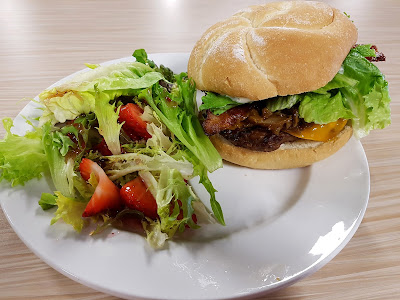Indoor Barbeque Burger with Strawberry Salad
Sportscaster Sid Waddell once said, “That’s the greatest
comeback since Lazarus.” Unlike Lazarus,
I may not have been literally dead, but this blog certainly hasn’t had a
heartbeat for a few years.
It has been two years since I graduated from VIU and, while
I have visited the campus on occasion, the opportunity did not arise to dine at
the cafeteria during that entire time. Of
course, it’s difficult to write a food review blog without tasting the food. Fortunately for me, I managed to have an
appointment on campus recently that would end at approximately the same time
that lunch was being served in the cafeteria.
A quick check of the VIU Food Services Facebook page revealed that an
“indoor barbeque” was on the menu.
I confess that when it comes to the topic of barbeque, I can
be a bit of a gourmet chef, myself. In
the past when I have had the opportunity to grill, I have made everything on
the barbeque from biscuits with a cedar plank pork loin to a smoked peach
upside down cake with caramel sauce. One
day a frequent dinner guest of mine was telling me about how he had bragged to
his co-worker about my barbeque skills by saying that I “could probably
barbeque Jell-o.” After I had a good
laugh at his comment, I took it as a challenge and actually created a recipe
for making Jell-o on the barbeque. Trust
me; I know how to barbeque.
Initially I was enthused about having a barbeque burger from
the cafeteria; however, I have to admit that I was skeptical of the fact that
it was an “indoor” barbeque. An “indoor
barbeque” is an oxymoron. Unless you are
cooking with an indoor smoker, or a giant cooking pit that is well ventilated (such
as the kind that can be only found in smokehouses), you are actually cooking on
an indoor grill. A grill does not impart
the flavour of wood smoke. A grill
cannot infuse the meat with the primal taste of the burning wood. True barbeque flavour needs true smoke, and
to the best of my knowledge the cafeteria does not have the means to infuse
this smoke flavour into its food while simultaneously eliminating the actual
smoke from the kitchen.
Sometimes it’s nice to be proven wrong, however. I found the cafeteria burger to have that
smoky flavour. It was a mild flavour,
mind you, but at least it wasn’t the strong essence of liquid smoke. The meat was not exceptional, unfortunately,
and had the loose texture of a processed patty that was purchased from the
freezer section of a grocery store chain.
The bun appeared to have come from a bakery, and was not made on
campus. As a matter of fact, I was a
little unimpressed that guests at the cafeteria had to retrieve their bun
directly from the plastic bag. I may not
have taken a food safety course, but I was rather turned off that my hand was
reaching into the same bag that many other unwashed hands had been into. All I could do was hope that the other hands were
somewhat clean prior to handling that food.
Personally, I would have preferred the buns to have been removed from
the bag by one of the cooks or servers, just for the reassuring knowledge that
only clean hands had come into contact with the bag.
One might think that a burger is just a burger and that is
the end of this review, but let us not forget the condiments and the
sides. While the cold staples such as
cheese slices, mayonnaise, ketchup, mustard, and relish were all traditionally
produced by off-campus sources, I am happy to say that the caramelized onions
were not. The caramelized onions must
have been made in the kitchen on campus, and they were delicious! In retrospect, I should have asked for a
double serving of them. The savoury, yet
sweet taste of softened, thinly sliced onions were a delight to my taste buds
and balanced quite well with the salty and chewy bacon slices that were also
cooked perfectly and added to my burger.
I opted to pass on the French fries and have a salad as my
side dish, and much to my delight it had a raspberry vinaigrette and
strawberries. I confess that
strawberries are my favourite food, so perhaps I am a little biased when it
comes to anything with strawberries in it.
It has been a while since I have had strawberries in a salad, and the
combination of berries and lettuce tasted wonderful. The strawberries were unusually strong and
sweet, which initially confused me.
Local strawberries, which are normally the only kind of naturally sweet
and flavourful strawberries that you can buy, were not quite in season at the
time of this lunch. How did the chefs
manage to find such a bold berry? I
suspect that the strawberries in the salad had been imported and marinated in a
combination of large amounts of sugar and artificial strawberry
flavouring. Unfortunately this strong
flavour of strawberry overpowered the both the strawberries and the raspberry
vinaigrette that I chose. I would
suggest that next time the chefs either scale back the sugar and artificial
strawberry flavours that are added to the imported strawberries, or better yet leave
the strawberries alone and make a vinaigrette from a combination of natural
strawberry juice, olive oil, and a balsamic reduction.
Overall, I would say that it was a flavourful lunch, which
was not what I expected from an indoor barbeque and, as always with VIU food,
it was reasonably priced.
It was good to be back for a visit to try the cafeteria food
once again, and I look forward to my next visit when I hope to enjoy a meal in
the Discovery Room. Just don’t expect
this to be my final blog entry, as I am certainly not dead.



